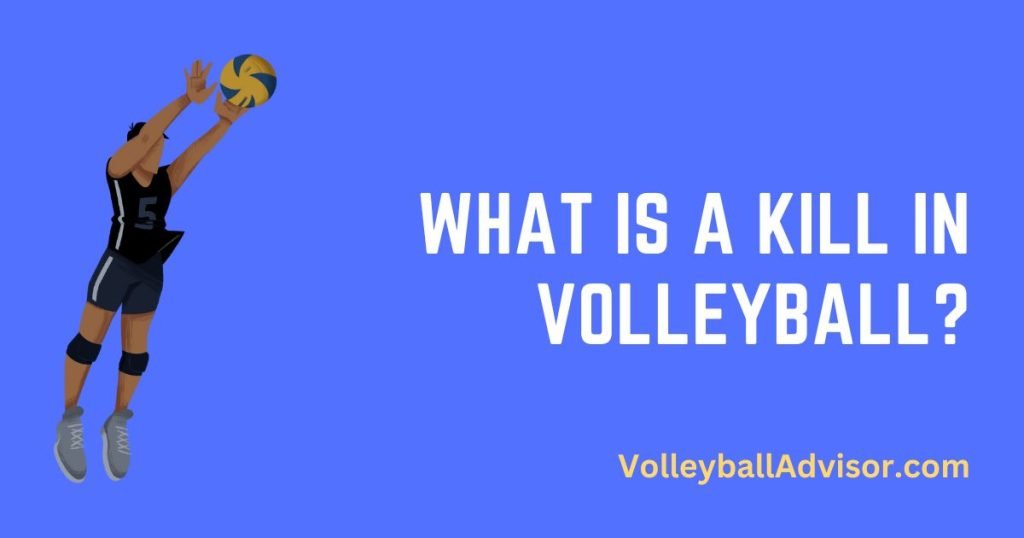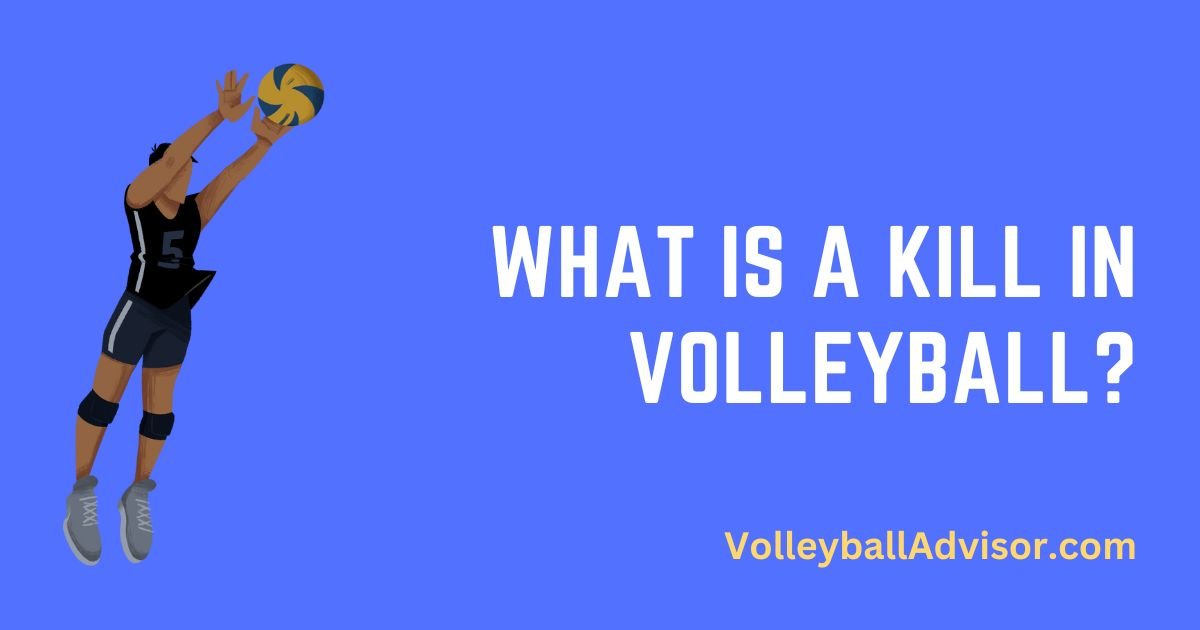A kill in volleyball is a successful offensive attack that results in an immediate point for the attacking team.
It occurs when a player hits the ball over the net, and lands inbound on the opponent’s side of the court or deflects off an opposing player and go out of bounds.
Volleyball Kills Definition
A kill (K) is awarded to a player any time an attack is unreturnable by the opposition and is a direct cause of the opponent not returning the ball, or any time the attack leads directly to a blocking error by the opposition.
A kill leads directly to a point. When a player is awarded a kill, the player also is awarded an attack attempt.

Kills showcase a player’s skill, power, and strategic thinking, as they must identify and exploit gaps in the opponents’ defense to score.
In a volleyball match, kills are crucial for scoring points, building momentum, and putting pressure on the opposing team.
Importance of kills in the game
Kills are a crucial aspect of volleyball, as they are the primary method for scoring points and putting pressure on the opposing team.
A kill occurs when a player successfully attacks the ball, lands on the opponent’s court, or deflects off an opposing player and goes out of bounds, resulting in a point for the attacking team.
Kills not only contribute to the team’s score but also help build momentum, boost players’ confidence, and break down the opponent’s defense. Developing the ability to execute kills effectively can significantly impact a team’s overall performance and success in a match.
Volleyball Kill Percentage
Volleyball kill percentage, also known as hitting efficiency or kill efficiency, is a statistic used to measure an attacker’s offensive performance in a match. It takes into account the number of kills, errors, and total attempts to provide a more comprehensive view of a player’s effectiveness in attacks.
To calculate the kill percentage, use the following formula:
Kill Percentage = (Kills – Errors) / Total Attempts
where
- Kills represent the total number of successful attacks resulting in points,
- Errors are the total number of attacking errors, such as hitting out of bounds or into the net,
- Total Attempts are the total number of attack attempts made by the player.
The resulting percentage helps to assess the effectiveness of a player’s attacks by considering both their ability to score points and their propensity for making errors.
A higher kill percentage indicates a more efficient and reliable attacker, while a lower percentage may suggest a need for improvement in the player’s attacking skills or decision-making.
What Is A Stuff Block In Volleyball?
A stuff block, also known as a roof or stuffed block, is a defensive move in volleyball where a blocker successfully deflects the ball back into the attacking team’s court, resulting in an immediate point for the defending team.
This occurs when a blocker jumps and positions their hands and arms over the net in such a way that the ball hits the blocker’s hands and falls straight down onto the attacker’s side of the court, often leaving the attacking team with no chance to recover the ball.
A stuff block is a particularly satisfying and momentum-shifting play in volleyball, as it not only scores a point but also demonstrates dominance over the attacker and can disrupt the attacking team’s rhythm.
Effective stuff blocks require good timing, proper hand and arm positioning, the anticipation of the attacker’s movements, and strong vertical jumping ability.
Definition of a Kill in Volleyball
Explanation of the term ‘kill’
A ‘kill’ in volleyball refers to an offensive attack by a player that results in an immediate point for their team.
It is a successful and aggressive play that often involves a forceful or well-placed hit, making it difficult for the opposing team to return the ball. Kills showcase a player’s skill, power, and strategic thinking, as they must identify and exploit gaps in the opponents’ defense to score.
Scoring a point through a kill
A point is scored through a kill when the ball lands on the opponent’s side of the court, either inbounds or by deflecting off a defending player and going out of bounds.
Kills can also result in points if the opposing team commits a blocking or receiving an error, such as a lift, double touch, or a player touching the net during the attempt to block or receive the attack.
A well-executed kill can shift the momentum of a game and create opportunities for the attacking team to further exploit the weaknesses of their opponents.
Types of Kills
A successful volleyball attacker must have a diverse range of skills and techniques to keep the opposing team’s defense guessing.
Different types of kills are employed to exploit various weaknesses in the opponents’ defense or to adapt to the blockers’ positioning.
Each type of kill has its unique advantages and challenges, and understanding when and how to use them effectively can significantly improve a player’s offensive abilities.
Here are four common types of kills in volleyball:
Power kills
Power kills are forceful, high-velocity attacks that overwhelm the opposing team’s defense with sheer speed and power.
These kills usually come from a strong, well-timed approach, followed by a high vertical jump and a fast, powerful arm swing.
Power kills are difficult to defend against due to their speed, and when executed correctly, they can significantly disrupt the opponent’s defensive formation.
Placement kills
Placement kills rely on strategic ball placement rather than power, aiming to exploit gaps or weaknesses in the opponent’s defense.
These kills may involve hitting the ball to an undefended area of the court or targeting a weaker passer on the opposing team.
A successful placement kill requires good vision, court awareness, and the ability to adjust one’s attack based on the positioning of the defenders.
Tip kills
Tip kills involve a player using their fingertips to lightly push or tap the ball over the blockers and into an open space on the opponent’s court.
This type of kill takes advantage of the opposing team’s expectation of a powerful attack, catching them off guard and leaving them unprepared to defend against a delicate touch.
Tip kills require finesse, accuracy, and a keen sense of timing to be effective.
Off-speed kills
Off-speed kills are attacks that deliberately reduce the speed of the ball, making it harder for the opposing team to anticipate and react to the attack.
These kills can involve a variety of techniques, such as roll shots, where the attacker contacts the ball with a relaxed hand and rolls it over the blockers, or cut shots, which are sharp, angled hits that change the ball’s trajectory.
Off-speed kills are particularly effective against well-formed defenses, as they force defenders to quickly adjust their positioning and can potentially disrupt their defensive rhythm.
How Do You Get More Kills In Volleyball?
To consistently execute successful kills in volleyball, players need to develop various skills and techniques that allow them to adapt to different game situations and exploit the weaknesses of the opposing team. Here are five essential skills and techniques for executing kills:
A. Proper approach
A strong, controlled approach is the foundation of an effective attack. Players should focus on their footwork, taking quick, explosive steps to generate momentum and transfer that energy into their jump.
A well-timed and balanced approach helps attackers position themselves optimally for the hit, improving their chances of a successful kill.
B. Arm swing and follow-through
An efficient arm swing and follow-through are crucial for generating power and control in an attack.
Players should focus on engaging their core and using their shoulders to create a whipping motion, snapping their wrist at contact to generate topspin and improve ball control.
Following through with the arm swing ensures a smooth transfer of energy and can help direct the ball towards the desired target.
C. Vertical jump and timing
A high vertical jump and proper timing are essential for hitting the ball at its peak and maximizing the chances of a kill.
Players should focus on explosive leg strength and core stability to improve their jumping ability.
Practicing the timing of the approach, jump, and arm swing can help players hit the ball consistently at the optimal height for a successful attack.
D. Vision and court awareness
Good vision and court awareness are critical for identifying gaps in the opponent’s defense and selecting the most effective type of kill.
Players should keep their eyes on the opposing team’s formation and be aware of the positioning of the blockers and defenders.
This knowledge enables attackers to make informed decisions about the best attack strategy and improve their chances of scoring a kill.
E. Communication with teammates
Effective communication with teammates is crucial for coordinating offensive plays and ensuring a successful kill attempt.
Players should communicate their intentions, such as the type of set they want or their intended target area, to help the setter and other attackers understand the plan.
Clear and concise communication can help create better opportunities for kills and improve overall team performance.
Importance of Kills in a Volleyball Match
Kills play a vital role in determining the outcome of a volleyball match. A team that can consistently execute kills has a significant advantage over its opponents. Here are four reasons why kills are important in a volleyball match:
A. Building momentum and confidence
Successful kills can help build momentum for the attacking team, boosting their confidence and motivation. A well-executed kill can shift the energy of a game in favor of the scoring team, inspiring them to maintain their offensive pressure and play more aggressively.
B. Breaking the opponent’s defense
Kills are crucial for breaking down the opponent’s defense, forcing them to adjust their strategy and positioning. By exploiting weaknesses in the opposing team’s formation, a successful kill can disrupt their defensive rhythm and create opportunities for further attacks.
C. Creating opportunities for teammates
Executing kills not only scores points but also creates opportunities for teammates to contribute offensively. When a player scores a kill, it often forces the opposing team to adjust their defense, potentially opening up gaps for other attackers to exploit. This can lead to a more balanced and effective team offense.
D. Contributing to overall team success
Kills are a significant factor in a team’s overall success, as they directly contribute to the score and help dictate the pace of the game. A team that can consistently execute kills puts continuous pressure on their opponents, making it challenging for them to mount a successful defense or offense. Ultimately, a team’s ability to score kills can be the deciding factor in winning a match.
